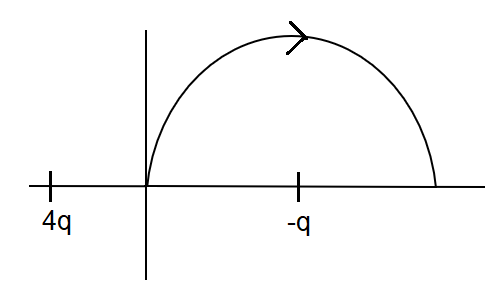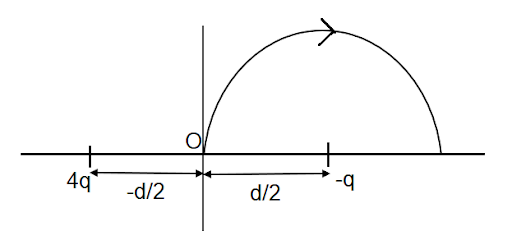
Two points charges 4q and –q are fixed on the x-axis at x = \[ - \left( {\dfrac{d}{2}} \right)\] and x =\[\left( {\dfrac{d}{2}} \right)\] , respectively. If a third point charge ‘q’ is taken from the origin to x = d along the semicircle as shown in the figure, the energy of the charge will:

A. decrease by \[\dfrac{q^2}{{4\pi {\varepsilon _0}d}}\]
B. decrease by \[\dfrac{{4q^2}}{{3\pi {\varepsilon _0}d}}\]
C. increase by \[\dfrac{{3q^2}}{{4\pi {\varepsilon _0}d}}\]
D. increase by \[\dfrac{{2{q^2}}}{{3\pi {\varepsilon _0}d}}\]
Answer
218.7k+ views
Hint: To solve this question first we need to find initial potential energy and final potential energy. After subtracting the both we get the change in potential energy. Electric potential energy is defined as the energy that is required to move a charge opposite to the electric field.
Formula used:
The potential energy is given as,
\[U = \dfrac{1}{{4\pi {\varepsilon _0}}}\dfrac{q}{r}\]
Where q is the charge, r is the distance and \[{\varepsilon _0}\] is the permittivity.
Complete step by step solution:

Image: Two point charges 4q and –q are at a distance of \[ - \left( {\dfrac{d}{2}} \right)\] and \[\left( {\dfrac{d}{2}} \right)\] on the x-axis with respect to origin.
As we know the initial potential energy is given as,
\[{U_i} = \dfrac{1}{{4\pi {\varepsilon _0}}}\left[ {\dfrac{{4{q^2}}}{{\left( {\dfrac{d}{2}} \right)}} - \dfrac{{{q^2}}}{{\left( {\dfrac{d}{2}} \right)}}} \right]\]
As the final potential energy is given as,
\[{U_f} = \dfrac{1}{{4\pi {\varepsilon _0}}}\left[ {\dfrac{{4{q^2}}}{{\left( {\dfrac{{3d}}{2}} \right)}} - \dfrac{{{q^2}}}{{\left( {\dfrac{d}{2}} \right)}}} \right]\]
Now the change in potential energy will be
\[\Delta U = {U_f} - {U_i}\]
\[\Rightarrow \Delta U =\dfrac{1}{{4\pi {\varepsilon _0}}}\left[ {\dfrac{{4{q^2}}}{{\left( {\dfrac{{3d}}{2}} \right)}} - \dfrac{{{q^2}}}{{\left( {\dfrac{d}{2}} \right)}}} \right]\]-\[\dfrac{1}{{4\pi {\varepsilon _0}}}\left[ {\dfrac{{4{q^2}}}{{\left( {\dfrac{d}{2}} \right)}} - \dfrac{{{q^2}}}{{\left( {\dfrac{d}{2}} \right)}}} \right]\]
\[\therefore \Delta U = - \dfrac{{4{q^2}}}{{3\pi {\varepsilon _0}d}}\]
Here the negative sign shows the decreasing energy. Therefore, the energy of the charge will decrease by \[\dfrac{{4{q^2}}}{{3\pi {\varepsilon _0}d}}\].
Hence option B is the correct answer.
Note: As we know the energy that is needed to move a charge against an electric field. We need greater energy to accelerate a charge in the electric field but also greater energy to move it through a stronger electric field. At any given point in an electric field the electric potential energy is the electric potential multiplied by the amount of charge at that point. So, the voltage gives you how much potential energy could have at some point which is not dependent on how much charge you put there.
Formula used:
The potential energy is given as,
\[U = \dfrac{1}{{4\pi {\varepsilon _0}}}\dfrac{q}{r}\]
Where q is the charge, r is the distance and \[{\varepsilon _0}\] is the permittivity.
Complete step by step solution:

Image: Two point charges 4q and –q are at a distance of \[ - \left( {\dfrac{d}{2}} \right)\] and \[\left( {\dfrac{d}{2}} \right)\] on the x-axis with respect to origin.
As we know the initial potential energy is given as,
\[{U_i} = \dfrac{1}{{4\pi {\varepsilon _0}}}\left[ {\dfrac{{4{q^2}}}{{\left( {\dfrac{d}{2}} \right)}} - \dfrac{{{q^2}}}{{\left( {\dfrac{d}{2}} \right)}}} \right]\]
As the final potential energy is given as,
\[{U_f} = \dfrac{1}{{4\pi {\varepsilon _0}}}\left[ {\dfrac{{4{q^2}}}{{\left( {\dfrac{{3d}}{2}} \right)}} - \dfrac{{{q^2}}}{{\left( {\dfrac{d}{2}} \right)}}} \right]\]
Now the change in potential energy will be
\[\Delta U = {U_f} - {U_i}\]
\[\Rightarrow \Delta U =\dfrac{1}{{4\pi {\varepsilon _0}}}\left[ {\dfrac{{4{q^2}}}{{\left( {\dfrac{{3d}}{2}} \right)}} - \dfrac{{{q^2}}}{{\left( {\dfrac{d}{2}} \right)}}} \right]\]-\[\dfrac{1}{{4\pi {\varepsilon _0}}}\left[ {\dfrac{{4{q^2}}}{{\left( {\dfrac{d}{2}} \right)}} - \dfrac{{{q^2}}}{{\left( {\dfrac{d}{2}} \right)}}} \right]\]
\[\therefore \Delta U = - \dfrac{{4{q^2}}}{{3\pi {\varepsilon _0}d}}\]
Here the negative sign shows the decreasing energy. Therefore, the energy of the charge will decrease by \[\dfrac{{4{q^2}}}{{3\pi {\varepsilon _0}d}}\].
Hence option B is the correct answer.
Note: As we know the energy that is needed to move a charge against an electric field. We need greater energy to accelerate a charge in the electric field but also greater energy to move it through a stronger electric field. At any given point in an electric field the electric potential energy is the electric potential multiplied by the amount of charge at that point. So, the voltage gives you how much potential energy could have at some point which is not dependent on how much charge you put there.
Recently Updated Pages
A square frame of side 10 cm and a long straight wire class 12 physics JEE_Main

The work done in slowly moving an electron of charge class 12 physics JEE_Main

Two identical charged spheres suspended from a common class 12 physics JEE_Main

According to Bohrs theory the timeaveraged magnetic class 12 physics JEE_Main

ill in the blanks Pure tungsten has A Low resistivity class 12 physics JEE_Main

The value of the resistor RS needed in the DC voltage class 12 physics JEE_Main

Trending doubts
JEE Main 2026: Application Form Open, Exam Dates, Syllabus, Eligibility & Question Papers

Derivation of Equation of Trajectory Explained for Students

Hybridisation in Chemistry – Concept, Types & Applications

Understanding the Angle of Deviation in a Prism

Understanding Collisions: Types and Examples for Students

Understanding Atomic Structure for Beginners

Other Pages
JEE Advanced Marks vs Ranks 2025: Understanding Category-wise Qualifying Marks and Previous Year Cut-offs

How to Convert a Galvanometer into an Ammeter or Voltmeter

Understanding Centrifugal Force in Physics

Ideal and Non-Ideal Solutions Explained for Class 12 Chemistry

Degree of Dissociation: Meaning, Formula, Calculation & Uses

Understanding Electromagnetic Waves and Their Importance




